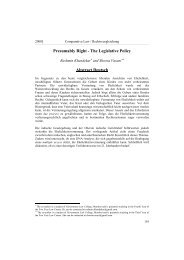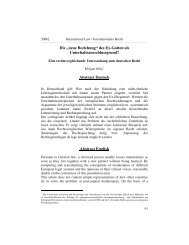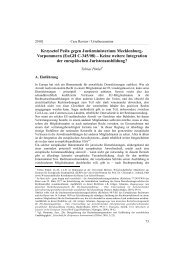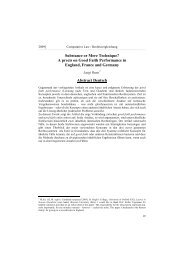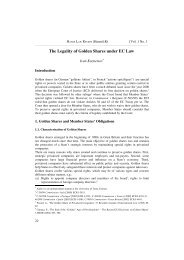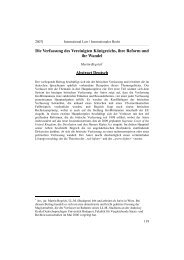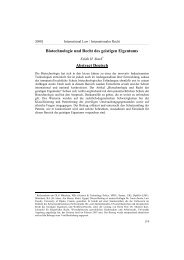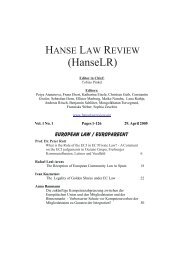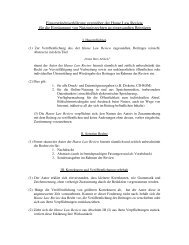The United Nations – a Kantian Dream Come True? - Hanse Law ...
The United Nations – a Kantian Dream Come True? - Hanse Law ...
The United Nations – a Kantian Dream Come True? - Hanse Law ...
You also want an ePaper? Increase the reach of your titles
YUMPU automatically turns print PDFs into web optimized ePapers that Google loves.
HANSE LAW REVIEW (<strong>Hanse</strong>LR) [Vol. 5 No. 1<br />
___________________________________________________________________________________________________________________________________________________<br />
Perpetual Peace, too, is designed to serve this moral-political purpose: ‘unlimited and at<br />
the same time unconditional peace’. 72<br />
In most of these aspects the Charter of the <strong>United</strong> <strong>Nations</strong> reads like a 20 th century<br />
restatement of the Königsberg peace essay: 73 ‘to save succeeding generations from the<br />
scourge of war’, ‘[to] live together in peace’, ‘to unite our strength to maintain international<br />
peace and security’ are only some of the ambitious goals specified in the UN-Charter<br />
preamble. In Art 1(1) UNC the maintenance of international peace and security even heads<br />
the list of the organisation’s purposes, the second paragraph of the same article immediately<br />
recalls ‘to take [...] measures to strengthen universal peace’ and the prohibition of the use of<br />
force in Art 2(4) UNC is almost tantamount to the <strong>Kantian</strong> call ‘<strong>The</strong>re shall be no war!’ 74 . 75<br />
Taking peace as the common goal for given at this point, though, would be jumping at<br />
conclusions. Given the possible distinction between inter-state and intra-state peace and<br />
the academic divide between positive and negative conceptions of peace one doubt remains<br />
to be cleared up: Does the assumption of a shared aim hold even beyond a mere accordance<br />
of wording?<br />
b) Global Peace <strong>–</strong> an Interstate Concept?<br />
Since Perpetual Peace is a theory of international right, the peace it endorses is (mainly) a<br />
peace inter nationes, a peace between states. <strong>The</strong> reason for this is that Kant’s theory faces<br />
a situation in which there is no need to pacify the relation between individuals anymore:<br />
they have already left the state of nature when they formed nation states and have entered a<br />
legal civil constitution. But not so have states. For states already being legally structured, at<br />
least internally, the state of nature remaining to be overcome is not an entirely lawless state.<br />
Rightly, Höffe characterises it as a residual state of nature (Rest-Naturzustand) 76 which has<br />
to be resolved by an association of states for the protection of their rights (not individual<br />
rights) 77 . Aiming at ‘international peace and security’ 78 , the UN Charter, at least in theory,<br />
acknowledges this inter-national scope of the <strong>Kantian</strong> conception. 79 In practice however,<br />
conflicts the UN have dealt with did not always transcend the national boarders and even<br />
the respective resolutions of the Security Council have occasionally done without the<br />
reference to a particular cross-border dimension of the threat to peace. In fact many times,<br />
the resolution of inner state conflicts <strong>–</strong> mostly involving severe violations of human rights <strong>–</strong><br />
has constituted the focal point and the primary concern of Security Council measures; even<br />
72 Höffe, ‘Ausblick: Die Vereinten Nationen im Lichte Kants’, 245; similar Kriele, Martin, ‘Menschenrechte und<br />
Friedenspolitik’, in Börner, B. (ed), Einigkeit und Recht und Freiheit (Heymanns, Köln, 1984), 661, 662: ‘a lasting<br />
world peace’.<br />
73 Höffe, ‘Ausblick: Die Vereinten Nationen im Lichte Kants’, 250; Lorz, 97 und Negretto, Gabriel L., ‘Kant and<br />
the Illusion of Collective Security’, [1993] 46 Journal of International Affairs 501, 502; Schmidt, 17.<br />
74 Kant, ‘<strong>The</strong> Metaphysics of Morals’, 174.<br />
75 Laberge, 94.<br />
76 Höffe, ‘Völkerbund oder Weltrepublik?’, 115.<br />
77 One exception of course is the relation of individuals to foreign states and the cosmopolitan right.<br />
78 See, e.g., Art 1(1), Art 2(3), (6), Art 11(1), (2), (3), Art 12(2), Art 15(1) UNC (italics added) to name only some.<br />
Here, it should be noted that Art 1(1) UNC refers to ‘universal peace’. A universal peace, however <strong>–</strong> since<br />
universal <strong>–</strong> excludes the limitation on inter-state relations and will therefore include peace on an innerstate, interindividual<br />
level. From a <strong>Kantian</strong> perspective it would have been preferable to stick to the expression ‘international<br />
peace and security’ even though the drafters probably did not intend a different meaning.<br />
79 Frowein, Jochen Abr. and Krisch, Nico, ‘Art 39 UNC’, in Simma, n. 7; Cot, Jean-Pierre and Pellet, Allain, La<br />
Charte des <strong>Nations</strong> Unies (Economica, Paris, 1985), 32.<br />
58



